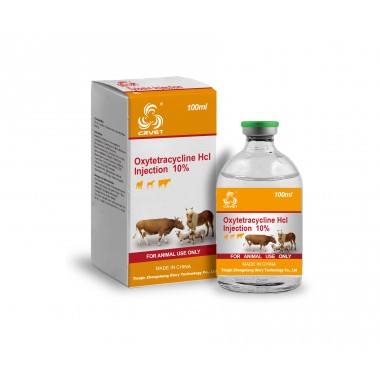Oxytetracycline injection 10%
Veterinary
NAME: Oxytetracycline injection 10%
COMPOSITION:
Each ml contains: Oxytetracycline 100mg
CHARACTER:
The product is yellow to light brown-yellow clear liquid.
PHARMACOLOGICAL ACTION:
Oxytetracycline is primarily bacteriostatic and is thought to exert its antimicrobial effect by the inhibition of protein synthesis. Oxytetracycline is active against a wide range of gram-negative and gram-positive organisms. The drugs in the tetracycline class have closely similar antimicrobial spectra and cross resistance among them is common. Micro-organisms may be considered susceptible of the M.I.C. (Minimum inhibitory concentration) is not more than 4.0 mcg/ml and intermediate if the M.I.C.is 4.0 t0 12.5mcg/ml.
PHARMACOKINETICS:
Oxytetracyclines are readily absorbed and are bound to plasma proteins in varying degree. They are concentrated by the liver in the bile and excreted in the urine and faeces at high concentrations and in a biologically active form. Oxytetracycline is the least lipid soluble derivative among tetracycline class.
INDICATIONS:
Oxytetracycline is indicated in infections caused by the following micro-organisms. Rickettsiae (rocky mountain spottedfever, typhus fever and the typhus group. Q fever. rickettsial pox and tick fevers). Mycoplasma pneumoniae agents of psittacosis and ornithosis agents of lymphogranuloma venereum and granuloma inguinale; the spirochaetal agent of relapsing fever(Borrelia recurrentis).
Infection caused by the following gram-negative micro organisms: Hemophilus
ducreyl (chancroid). Pasteurella pestis and P. tularensis, Bartonella bacilliformis, Bacteroides species, Vibrio Comma and Vfetus, Brucella species (In conjunction with streptomycin).
Oxytetracycline is indicated for treatment of infections caused by the following
gram-negative and gram-positive micro-organisms, when bacteriologic testing
indicates appropriate susceptibility to the drug.
Gram-negative: Escherichia coli, Enterobacter aerogenes, Shigella species, Mima species and Herellea species, Haemophilus influenzae (respiratory infections), klebsiella species (respiratory and urinary infections).
Gram-Positive: Streptococcus Species-up t0 44% of strains of S. pyogenes and 74 of S. Faecalines have been found to be resistant to tetracycline drugs. Therefore, Oxytetracyclines should not be used unless the organism has been demonstrated to be sensitive. Tetracycline are not the drugs of choice in the treatment of any type of staphylococal infections. When penicillin is contraindicated tetracyclines are alternative drugs in the treatment of infections due to Neisseria gonorhoeae. Treponema pallidum and T.pertenue (syphilis and yaws) Listeria monocytogenes, clostridium species, Bacillus anthracis, Fusobacterium fusiform(vincent's infection),Actinomyces species N.meningitidis (IV only).
CLINICAL APPLICATION:
Wide range of organisms including bacterial & protozoans
Gram-negative and Gram-positive bacteria
Examples include Brucella, Francisella, Pseudomonas pseudomallei, Neisseria gonorrhoea, and Treponema pallidum.
Many Pasteurellae and Borrelia hurgdorferi(Lymedisease)
Common in Vet Med
Combination with sulfas (e.g., Sulfadimethoxine [Albon] with which they are
synergistic. Used to treat most Streptococcus, Staphylococcus, Pasteurella
infections in cattle [Bowersock 1995].
Rickettsial infections
eg.,Q fever and Rocky Mountain Spotted Fever, Mycoplasmas and Chlamydia
Often pneumonia and genitourinary tract infections
Psittacosis - Chlamydia psittaci
Malaria and ameobiasis in combo with other drugs
Demeclocycline-
SIADH - syndrome of inappropriate (excess) antidiuretic hormone
Non - infections
Inhibits ADH-included water reabsorption
CONTRAINDICATIONS:
The drug is contraindicated inanimals who have shown hypersensitivity to any of the tetracyclines.
WARNINGS:
Animal studies indicate that oxytetracycline crosses the placenta and found in fetal tissues and can have toxic effects on the developing foetus (often related to retardation of skeletal development)
Evidence of embryotoxicity has also been noted in animals treated early in pregnancy The usage of Oxytetracycline during tooth development (last half of pregnancy, infancy) may cause permanent discolouration of teeth (Yellow-Grey-Brown). Therefore should not be used in this age group unless other drugs are not likely to be effective or are contraindicated. Oxytetracycline are present in the milk of lactating animal who are taking this drug.
PRECAUTIONS:
Oxytetracycline intramuscular solution should be injected well within the body of a relatively large muscle. As with all intramuscular injections aspiration is necessary to help avoid inadvertent injection into a blood vessel. lf any super infection occurs the oxytetracycline should be discontinued and appropriate therapy instituted. Since bacteriostatic drugs may interfere with the bactericidal action of penicillin, It is advisable to avoid giving tetracycline drugs in conjunction with penicillin.
ADVERSE REACTIONS:
Local imitation may be present after intramuscular injection of oxytetracycline.
Gastro intestinal; anorexia, nausea vomiting diarrhoea, glossitis duphagia,
enterocolitis, inflammatory lesions and hypersensitivity reactions haemolytic anemia thrombocytopenia, neutropenia and eosinophillia have been reported.
DOSAGE AND ADMINISTRATION:
Deep Intramuscular Injections:
Cattle, Horse, Camel, Sheep, Goat, Pig:
10mg-20mg per kg body weight
WITHDRAWAL PERIOD:
Meat: 7 days
Milk: 28 days
SHELF TIME:
3 years.
STORAGE:
Keep in cool and dark place. Keep out of the children.
PACKING:
100ml per bottle






